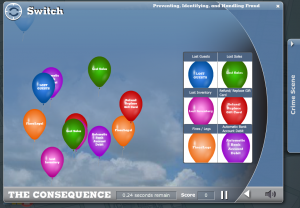Quick: What are the fundamentals of Instructional Design?
…
In your list, did you include content analysis? So much of the time we’re so intent on figuring out tools, audience needs and evaluation that clear and understandable content is overlooked. Often, the contract work that Brandon and I did would have a large unplanned and un-budgeted component of deciphering content provided by the client. We would often be asked to design instructional materials when the content was both repetitive and incomplete. One such case was a credit card compliance training for managers of fast food franchises. We used the following techniques to make 55+ PowerPoint slides into an effective interactive learning experience.
Read for Purpose
The first read-through of instructional material requires switching between in-depth and surface reading. You’re reading for purpose– as a learner, digesting information and checking for gaps in the material — as a designer, you’re already preparing the best way to parse and re-arrange the material for understanding. This requires both deep concentration on details to ensure you grasp the content, and taking a big picture view to make sure there is an understandable context.
Identify Frameworks
Typically during the first few read-throughs, certain patterns emerge. Hidden within a linear narrative, we identified 8 distinct types of credit card fraud that the manager had to understand. Each type of fraud had a set of consequences, preventative measures, and follow-up procedures. There was a lot of content to grapple with both as a learner and a designer. We constructed tables to house data on fraud type and consequences, and fraud type and preventative measures to ensure that all content was transferred from the narrative content to our game-based activity.
Categorize Content and Identify Outliers
It can take multiple analyses to ensure that a framework accommodates all of content. It may be necessary add more categories, and/or combine others. Sometimes content simply won’t fit inside a framework– sometimes it is extraneous, and therefore excluded, and other times it’s critical for legal or compliance reasons. In this case, we found that securing the restaurant’s computer network was a measure that was useful in preventing only one type of fraud, a data breach. Accordingly, we were to sure to emphasize this measure in the applicable module.
Identify Repetition and Commonalities
As we looked at the source PowerPoint slides, we realized that there was a lot of repetition in 3 categories: consequences, preventative measures and steps to follow after an incident. Using tables helped us identify the shared traits AND the dissimilarities. Knowing the commonalities between the fraud types helped us in framing our instructions and influenced our use of predictable structure (discussed below) in making sense of the large amount of content.
Check in with SMEs
When doing a major re-organization of material, it’s important to ask for clarification and confirmation from your Subject Matter Experts. This is an opportunity to make sure that your assumptions and logical leaps are valid. By checking with the SMEs, we were able to confirm that most of our assumptions were correct, and they provided further helpful clarification. As you’re rephrasing to fit your narrative, you want to ensure that your language is still precise, and in the case of compliance-related instruction, ensure that it’s legally correct.
Use Predictable Structures
Most learners do best when there is some predictable structure that can help them make sense of material. Once we figured out the pattern of the material, we didn’t hide it from the learner. We explicitly structured our material around the pattern that allowed us to understand the complex, multi-step material. Each of the 8 modules described the fraud, gave a brief illustrative story of the fraud to frame context, and presented the consequences and the prevention.
The same activity was used throughout each module to reinforce the commonalities of the consequences.
Recognize Limitations
We were hired to do a fun, interactive game, and we delivered. But this was compliance training, and we realized that there were some very important procedural tasks that managers would have to do if they were unlikely enough to encounter fraud. We realized that having them enter a Flash game and hunt for procedures was not the best fit. We created a stand-along document with step by step instructions from corporate. There was no need to force this legal, procedural document into our crime narrative.
I find that a thorough, structural, content analysis allows me to feel confident that I have accounted for all my data, and therefore I can be creative and free when it comes to creating games and the interface.




